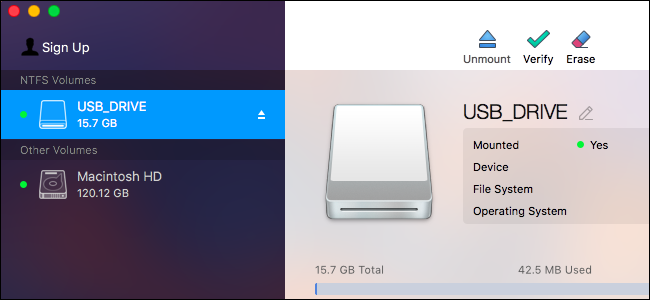

#Mac format ntfs drive windows 8
To do this on Windows 8 or Windows 7, press the Windows key once, type cmd, and press Ctrl+Shift+Enter. Next, open a Command Prompt window as administrator. For example, in the screenshot below, the Mac-formatted drive is Disk 2. First, note the number of the disk in the disk management window. This process erases everything on the disk, including its files and all its partitions. To erase this partition, we’ll have to wipe the entire disk. This partition is marked as protected, so you can’t just right-click and delete it - the delete option will be disabled. The Mac drive may have an “EFI System Partition” on it. You can then right-click in the empty space and select New Simple Volume to create a partition and format it with the Windows NTFS or FAT32 file systems. If you’re lucky, you can just right-click each partition on the Mac drive and select Delete Volume to remove the partitions. Be sure you’ve identified the Mac drive - if you accidentally delete partitions from another drive, you could damage your Windows installation or lose your files. if you need to format USB drive to NTFS/FAT32/exFAT/EXT 2,3,4/HFS+ file system, please follow the steps as below. Locate the Mac drive in the list of disks. After choosing the best format for USB drive according to your needs, you might start to wonder: how do I format USB drive to NTFS/FAT32/exFAT/EXT 2,3,4/HFS+ in Windows operating system or Mac Well, dont worry.
#Mac format ntfs drive for mac
Whichever way you choose, you’ll still need to install Tuxera NTFS for Mac to format your drive. That means on the latest Macs, you can use Apple’s Disk Utility or Tuxera Disk Manager to format your drive.
#Mac format ntfs drive drivers
This tool allows you to manage the partitions on drives connected to your computer - internal ones or external ones connected via USB. In Sierra, support for NTFS drivers returned to Apple’s Disk Utility. Press Windows Key + R to open the Run dialog, type diskmgmt.msc into the box, and press Enter to open it.

NTFS is a file format that is mostly used in Windows operating systems. One can use the Mac operating system to format any USB flash drive with the NTFS file system. The latest mac processor and operating system are also able to format different flash drives to NTFS. RELATED: Understanding Hard Drive Partitioning with Disk Managementįirst, open the Windows Disk Management tool. You can also read and write NTFS drives on any mac. You’ll probably want to uninstall Java when you’re done.Įrase the Mac Partitions, Including the EFI System Partition

For example, Time Machine can only back up to HFS+ formatted drives. Some Mac functions require an HFS+ formatted drive. There will be no space wasted by protected Mac partitions. The drive will now be formatted for use by Windows systems. HFSExplorer unfortunately requires you install Java to use it, but it’s the only free option here. Use the wizard to create a partition with the NTFS or FAT32 file system. If you only have Windows systems available, you can use HFSExplorer to copy files from the drive onto your Windows system drive or another drive. If you have a Mac lying around, you can plug the drive into a Mac and back up the files. Instead, we’ll just be wiping the drive and starting over from scratch. This process won’t actually convert the file system. First, back up the data on the Mac-formatted drive if you have anything important on it.


 0 kommentar(er)
0 kommentar(er)
